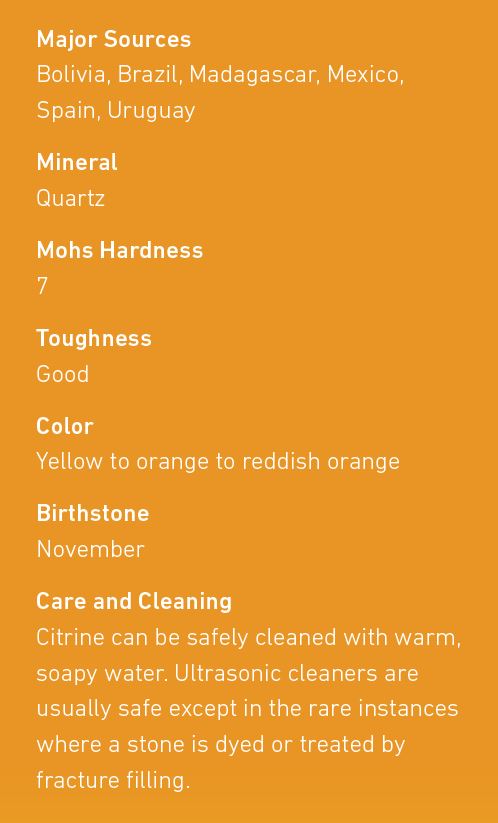CitrineBelieved to carry healing properties of the sun, with restorative powers for the body and soul. The name citrine comes from the French “citron” and
Latin “citrus” meaning lemon-colored. Citrine is a variety of quartz, and quartz has been used in jewelry for thousands of years. Naturally colored citrine is rare, and today most citrine quartz is the result of heat treatment of amethyst quartz. Even so, gems from the Victorian era have surfaced, demonstrating that citrine was treasured even in earlier times. Color Citrine is the transparent, pale yellow to brownish
orange variety of quartz and is quite rare in nature. In the days before modern gemology, its tawny color caused it to be confused with topaz. In the contemporary market, citrine’s most popular shade is an earthy deep brownish or reddish orange. The finest citrine color is a saturated yellow to reddish orange free of brownish tints. Clarity Eye-visible inclusions are not common in citrine but if
present they decrease its value. Source The top sources for natural citrine are Bolivia,
Spain, Madagascar, Mexico and Uruguay. Amethyst that is heat treated to a citrine color is mostly mined in Brazil. In Bolivia, amethyst and citrine colors can occur together in the same crystal. These unique gems are called ametrine. Treatments Most citrine is the result of heating, which converts
less valuable shades of purple amethyst to the golden shades of citrine. The saturation of the original amethyst hue will determine the richness of the resulting citrine yellow. Citrine’s attractive color, plus the durability and affordability it shares with most other quartz, make it a top-selling yellow to orange gem. |
These faceted citrines show the gem’s range
of color from yellow to reddish orange. |
All information are courtesy of Gemological Institute of America (GIA). OR DIAMOND are not affiliated with, connected to, or associated with GIA other than selling diamonds and gemstones graded by GIA and have GIA trained staff gemologist and accredited jewelry professional on site.
Images courtesy: Dr. Eduard J. Gübelin Collection; Steve Ulatowski, New Era Gems.




